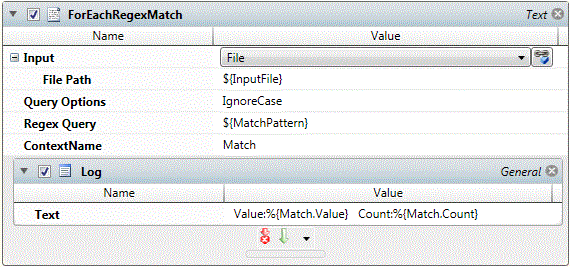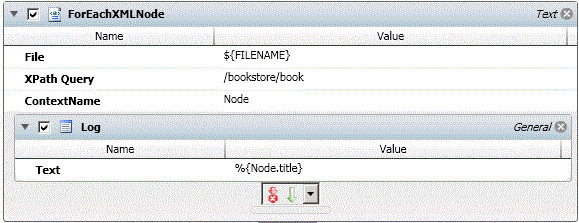Text
The Text steps support parsing a string using a regular expression, and parsing an XML file.
This job step allows you to parse a string using a regular expression and return a series of tokens that can be used to iterate through the parsed string.

Platforms Supported
Windows, UNIX-based.
Software Pre-Requisites
Design and Windows: None.
UNIX: Workflow Host Enabled Only.
Job Step Properties
Input – This dropdown property indicates the source of the data to be parsed. If File is selected, then you would specify a path to the file you want parsed. If String is selected, then you would specify the string to be parsed.
Query Options – This checkbox property indicates zero or more options you can specify that will alter the behavior of the RegEx parser.
RegEx Query – This property represents the Regular Expression to be used to parse the data.
ContextName – This property represents the Execution Variable that will hold a single iteration of parsed data. Nested job steps can access this data through the %{contextname} syntax. A sub-field is provided for nested job steps: .value. Value represents the string that was met the parser’s expression. If your Regular Expression culled the parsed data into groups you can specify Groups[0], Groups[1], etc. For example, %{Match.Groups[1]} would substitute the first group of matches; [0] is the entire string.
This job step allows you to parse an XML document and return each XML node for subsequent job step processing.

Platforms Supported
Windows, UNIX-based.
Software Pre-Requisites
Design and Windows: None.
UNIX: Workflow Host Enabled Only.
Job Step Properties
File – This property represents the specification of a file that contains an XML document.
XPath Query – This property represents the path within the XML document to begin the XML parse.
ContextName – This property represents the Execution Variable that will hold a single iteration of parsed XML data.Nested job steps can access this data through the %{contextname} syntax. Sub-fields of the XML data are returned through standard ActiveBatch syntax. For example, as in the above example, if an XML node contained the tag <TITLE> then %{node.title} would be used to access that field.